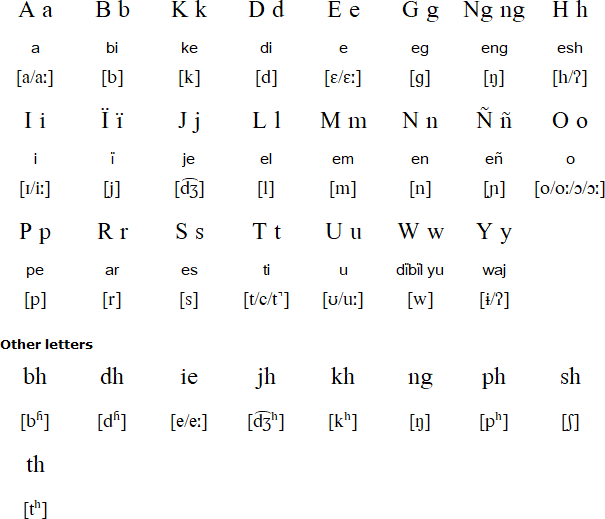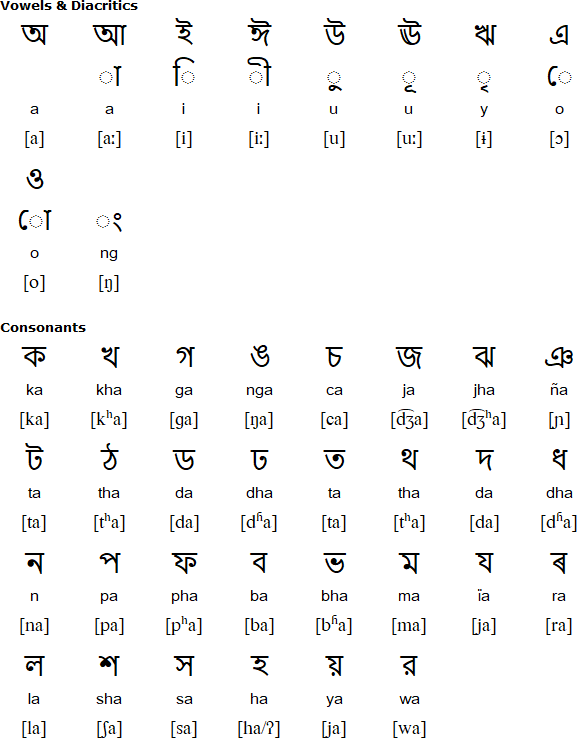Khasi is a member of the Khasic group of Austroasiatic languages. It is spoken by about 1 million people, mainly in Meghalaya state in the north-east of India, particularly in the districts of Jaintia Hills, East Khasi Hills and West Khasi Hills.
There are also speakers of Khasi in the Cachar, Kamrup, Lakhimpur, Nagaon and North Cachar Hills districts of Assam, in the Indian states of Manipur, Tripura and West Bengal, and in the Sylhet division in northeasten Bangladesh.
Khasi has been a officially recognised as a statutory provincial language in Meghalaya State since 1950, and was recognised as an associate offical language of Meghalaya in 2005. It is used in government, courts, the media and literature, and is taught in schools in Meghalaya and Bangladesh.
There are a number of dialects of Khasi, including Sohra, Khynriam and War, which are more or less mutually intelligible, and Bhoi and Nonglung, which are different enough to be considered distinct languages.
Khasi was first written with the Bengali alphabet by William Carey, a British missionary, in the early 19th century. Many Khasi books were written in the Assamese script, and Khasi was first written with the Latin alphabet by Thomas Jones, a Welsh missionary, in 1841. The Latin alphabet is used in Meghalaya, and other parts of India, and the Bengali-Assamese alphabet is used in Bangladesh.
Another way to write Khasi, known as the New Khasi Alphabet, was devised by Jüda F. Kapu from Umbir in Meghalaya


Download alphabet charts for Khasi (Excel)
Corrections by Eric Mawrie
যা কি বৃনৰ্যের বাৰহ লা খা লাচলোছ বাড কী যৰূঙ্কট হা কি বুৰম বাড ক হক. হাকি লা বৃস্যপ দা ক বৰ-পৃৰ্খট বাড ক চিংযাতিপলেম বাড হা ক মৃন্স্যেম চিংস্ঙেউ শীপাৰা, কী দেই বাণ যত্ৰেই বৃনৰাপ লাং.
Ïa ki bynriew baroh la kha laitluid bad ki ïaryngkat ha ka burom bad ki hok. Ha ki la bsiap da ka bor pyrkhat bad ka jingïatiplem bad ha ka mynsiem jingsngew shipara, ki dei ban ïatrei bynrap lang.
jaː ki bɨnreʊ baːrɔʔ laː kʰaː lacloc bat ki jaːrɨŋkat haː kaː burɔm bat ki hɔk. haː ki laː bsjap daː kaː bɔːr pɨrkʰat bat kaː dʒɪŋjaːtɪplɛm bat haː kaː mɨnseːm dʒɨŋsŋɛʊ ʃiparaː ki dɛɪ ban jaːtrɛɪ bɨnrap laŋ
All human beings are born free and equal in dignity and rights. They are endowed with reason and conscience and should act towards one another in a spirit of brotherhood.
(Article 1 of the Universal Declaration of Human Rights)
Information about Khasi | Numbers | Tower of Babel
Information about the Khasi language
https://en.wikipedia.org/wiki/Khasi_language
https://fr.wikipedia.org/wiki/Khasi
http://www.ethnologue.com/language/kha
https://cherrapunjee.com/the-language/
https://archive.org/details/in.ernet.dli.2015.460881/mode/2up
http://lisindia.ciil.org/Khasi/Khasi_Hist.html
Phrases in Khasi
https://rapidiq.wordpress.com/2012/08/16/survival-phrases-in-khasi-walking-in-the-abode-of-clouds/
http://learnkhasi.blogspot.co.uk
Languages written with the Latin alphabet
Atong, Bengali, Bishnupriya Manipuri, Bodo, Bhumij, Chittagonian, Garo, Hajong, Karbi, Kharia, Khasi, Koch, Koda, Kokborok, Kurmali, Malto, Manipuri, Mundari, Noakhailla, Rangpuri, Sadri, Santali, Sylheti, Toto, Tanchangya
Page last modified: 14.01.24
[top]
You can support this site by Buying Me A Coffee, and if you like what you see on this page, you can use the buttons below to share it with people you know.

If you like this site and find it useful, you can support it by making a donation via PayPal or Patreon, or by contributing in other ways. Omniglot is how I make my living.
Note: all links on this site to Amazon.com, Amazon.co.uk
and Amazon.fr
are affiliate links. This means I earn a commission if you click on any of them and buy something. So by clicking on these links you can help to support this site.
[top]